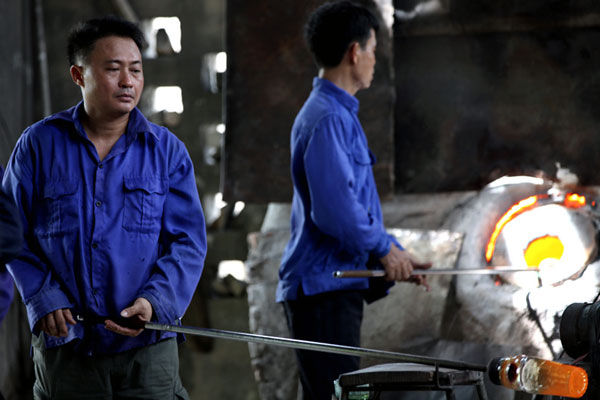Jorum’s are a large jug made of thick glass. Typically, it has two unique opaque shades of blue and white. The surface has a rough texture when you feel the glass.
While holding a full jorum in your hand, you can clearly see a layer of white foam, heaving at its lip. Perhaps, the beauty of draught beer (bia hoi) can only be appreciated when it’s poured into a jorum. You’ll have to try it!
Drinking beer, or bia hoi, with these jorums is great! We can simply lift them up or put them down, making sounds of clanking without the fear of breaking them. On the other hand, they’re fairly inexpensive, so it wouldn’t be a problem if they broke. Recyclable materials are used to craft each jorum. Every jorum is 100% hand-crafted.

It’s a lesser-known fact that the creator of these jorums, that we have been using all these years, was the famous artist Lê Huy Văn.
In 1974, the first jorum was released onto the marketplace. Not long after their release, jorums were being massed produced, based on sketches. It only took 2 years for the jorum glass to “swarm” the Hanoian marketplaces.
More than a hundred kilometers to the South, in Nam Định province, where there is the Xối Trì glassware village (in Nam Thanh commune), was the birthplace of these cheap blueish jorums, made by the intimate hands of experienced craftsmen.
Workshops recycle pieces of broken window glass that have been collected from around Hanoi. The broken glass, referred to as cullet, by the glass maker, is heated in a furnace to over 1000°c until it softens and melts. Then, a long pipe is dipped into the hot glass. The craftsmen slowly pulls a glob of glowing-orange glass out of the furnace. Afterwards, the hot glass is rolled on a table to cool while a rough cylindrical shape is skillfully formed. Lastly, the molten glass is swung and lowered into a split mold where a craftsman blows into the pipe to form an air bubble in the glass. Finally, the bubble gradually grows and forces the glass to take the shape of the inside of the mold.
Fans are used to cool the glass so that it keeps it’s new shape and the blowing pipe is deftly removed. During the final stage in the process, another worker carefully smooths the rim of the glass. The finished Bia Hoi glasses are covered in hot ash from the furnace to stop them from cooling too quickly, otherwise they would crack.

Even though these jorums are cheap and dull, they are close to the heart of every Hanoian. Some people think the design of the jorums is not the best, and the love everyone gave them during a time of hardship cannot speak to its true value.
In 2011, about 50,000 to 70,000 new glasses were manufactured only to pale in sales because they could never replace the jorums design advantages and the faith that customers had put upon them.
According to Huy Vân’s analysis, there are 3 reasons that have made the jorums become such a staple. A jorum is designed to be durable, simple, and suitable for beer drinking. Its simple jug design also helps make the manufacturing and transporting processes easier. Secondly, since jorums are made from recyclable materials, they’re easily replaced. This means their impact on the environment is minimal. Finally, it provides a certain feeling and creates a certain habit with customers. Once they are used to a product and can see its benefits, it is hard to find a replacement.

Even with its simplistic design, for 4 decades, no product has managed to replace the jorum. For years, these beer jorums have been close and familiar companions of Hanoians. Jorums are also proof that the simpler something is, the more long-lasting it will be. Jorums are not yet the past; they are part of the present, and no one can tell when these legendary jugs will fade out of existence.
Your visit to Hanoi is not complete without drinking Bia Hoi from a jorum!
It’s very easy to find Bia Hoi throughout Hanoi. There, you’ll sit on colorful mini plastic stools on the street like the locals do and enjoy a cold drink while making new friends and watching the world go by. An experience you’ll never forget!
